[English] 日本語
 Yorodumi
Yorodumi- PDB-7t11: CryoEM structure of somatostatin receptor 2 in complex with Octre... -
+ Open data
Open data
- Basic information
Basic information
| Entry | Database: PDB / ID: 7t11 | ||||||
|---|---|---|---|---|---|---|---|
| Title | CryoEM structure of somatostatin receptor 2 in complex with Octreotide and Gi3. | ||||||
 Components Components |
| ||||||
 Keywords Keywords | MEMBRANE PROTEIN/SIGNALING PROTEIN / GPCR / Receptor / Complex / MEMBRANE PROTEIN / MEMBRANE PROTEIN-SIGNALING PROTEIN complex | ||||||
| Function / homology |  Function and homology information Function and homology informationresponse to acrylamide / regulation of saliva secretion / sensory perception of temperature stimulus / positive regulation of eating behavior / somatostatin receptor activity / adenylate cyclase-inhibiting opioid receptor signaling pathway / G protein-coupled opioid receptor activity / negative regulation of luteinizing hormone secretion / dynorphin receptor activity / G protein-coupled opioid receptor signaling pathway ...response to acrylamide / regulation of saliva secretion / sensory perception of temperature stimulus / positive regulation of eating behavior / somatostatin receptor activity / adenylate cyclase-inhibiting opioid receptor signaling pathway / G protein-coupled opioid receptor activity / negative regulation of luteinizing hormone secretion / dynorphin receptor activity / G protein-coupled opioid receptor signaling pathway / peristalsis / positive regulation of dopamine secretion / sensory perception / positive regulation of potassium ion transmembrane transport / negative regulation of adenylate cyclase activity / maternal behavior / conditioned place preference / receptor serine/threonine kinase binding / neuropeptide binding / GTP metabolic process / cellular response to glucocorticoid stimulus / positive regulation of p38MAPK cascade / G protein-coupled dopamine receptor signaling pathway / eating behavior / response to starvation / positive regulation of macroautophagy / behavioral response to cocaine / G protein-coupled receptor signaling pathway, coupled to cyclic nucleotide second messenger / neuropeptide signaling pathway / estrous cycle / Adenylate cyclase inhibitory pathway / MECP2 regulates neuronal receptors and channels / axon terminus / forebrain development / T-tubule / sensory perception of pain / adenylate cyclase-inhibiting G protein-coupled receptor signaling pathway / cerebellum development / Peptide ligand-binding receptors / sarcoplasmic reticulum / cellular response to estradiol stimulus / locomotory behavior / response to nicotine / G protein-coupled receptor binding / PDZ domain binding / cellular response to glucose stimulus / response to insulin / G-protein beta/gamma-subunit complex binding / adenylate cyclase-modulating G protein-coupled receptor signaling pathway / Olfactory Signaling Pathway / Activation of the phototransduction cascade / G beta:gamma signalling through PLC beta / Presynaptic function of Kainate receptors / Thromboxane signalling through TP receptor / G protein-coupled acetylcholine receptor signaling pathway / G-protein activation / Activation of G protein gated Potassium channels / Inhibition of voltage gated Ca2+ channels via Gbeta/gamma subunits / Prostacyclin signalling through prostacyclin receptor / Glucagon signaling in metabolic regulation / G beta:gamma signalling through CDC42 / G beta:gamma signalling through BTK / ADP signalling through P2Y purinoceptor 12 / Sensory perception of sweet, bitter, and umami (glutamate) taste / Synthesis, secretion, and inactivation of Glucagon-like Peptide-1 (GLP-1) / photoreceptor disc membrane / synaptic vesicle membrane / Glucagon-type ligand receptors / Adrenaline,noradrenaline inhibits insulin secretion / Vasopressin regulates renal water homeostasis via Aquaporins / response to estrogen / G alpha (z) signalling events / Glucagon-like Peptide-1 (GLP1) regulates insulin secretion / ADORA2B mediated anti-inflammatory cytokines production / cellular response to catecholamine stimulus / sensory perception of taste / ADP signalling through P2Y purinoceptor 1 / G beta:gamma signalling through PI3Kgamma / adenylate cyclase-activating dopamine receptor signaling pathway / Cooperation of PDCL (PhLP1) and TRiC/CCT in G-protein beta folding / GPER1 signaling / GDP binding / cellular response to prostaglandin E stimulus / G-protein beta-subunit binding / Inactivation, recovery and regulation of the phototransduction cascade / heterotrimeric G-protein complex / G alpha (12/13) signalling events / extracellular vesicle / signaling receptor complex adaptor activity / Thrombin signalling through proteinase activated receptors (PARs) / GTPase binding / retina development in camera-type eye / presynaptic membrane / Ca2+ pathway / phospholipase C-activating G protein-coupled receptor signaling pathway / midbody / G alpha (i) signalling events / fibroblast proliferation / G alpha (s) signalling events / cellular response to lipopolysaccharide Similarity search - Function | ||||||
| Biological species |  Homo sapiens (human) Homo sapiens (human) synthetic construct (others) | ||||||
| Method | ELECTRON MICROSCOPY / single particle reconstruction / cryo EM / Resolution: 2.7 Å | ||||||
 Authors Authors | Robertson, M.J. / Skinotis, G. | ||||||
| Funding support | 1items
| ||||||
 Citation Citation |  Journal: Nat Struct Mol Biol / Year: 2022 Journal: Nat Struct Mol Biol / Year: 2022Title: Plasticity in ligand recognition at somatostatin receptors. Authors: Michael J Robertson / Justin G Meyerowitz / Ouliana Panova / Kenneth Borrelli / Georgios Skiniotis /  Abstract: Somatostatin is a signaling peptide that plays a pivotal role in physiologic processes relating to metabolism and growth through its actions at somatostatin receptors (SSTRs). Members of the SSTR ...Somatostatin is a signaling peptide that plays a pivotal role in physiologic processes relating to metabolism and growth through its actions at somatostatin receptors (SSTRs). Members of the SSTR subfamily, particularly SSTR2, are key drug targets for neuroendocrine neoplasms, with synthetic peptide agonists currently in clinical use. Here, we show the cryogenic-electron microscopy structures of active-state SSTR2 in complex with heterotrimeric G and either the endogenous ligand SST14 or the FDA-approved drug octreotide. Complemented by biochemical assays and molecular dynamics simulations, these structures reveal key details of ligand recognition and receptor activation at SSTRs. We find that SSTR ligand recognition is highly diverse, as demonstrated by ligand-induced conformational changes in ECL2 and substantial sequence divergence across subtypes in extracellular regions. Despite this complexity, we rationalize several known sources of SSTR subtype selectivity and identify an additional interaction for specific binding. These results provide valuable insights for structure-based drug discovery at SSTRs. | ||||||
| History |
|
- Structure visualization
Structure visualization
| Movie |
 Movie viewer Movie viewer |
|---|---|
| Structure viewer | Molecule:  Molmil Molmil Jmol/JSmol Jmol/JSmol |
- Downloads & links
Downloads & links
- Download
Download
| PDBx/mmCIF format |  7t11.cif.gz 7t11.cif.gz | 202.5 KB | Display |  PDBx/mmCIF format PDBx/mmCIF format |
|---|---|---|---|---|
| PDB format |  pdb7t11.ent.gz pdb7t11.ent.gz | 157.9 KB | Display |  PDB format PDB format |
| PDBx/mmJSON format |  7t11.json.gz 7t11.json.gz | Tree view |  PDBx/mmJSON format PDBx/mmJSON format | |
| Others |  Other downloads Other downloads |
-Validation report
| Summary document |  7t11_validation.pdf.gz 7t11_validation.pdf.gz | 816.2 KB | Display |  wwPDB validaton report wwPDB validaton report |
|---|---|---|---|---|
| Full document |  7t11_full_validation.pdf.gz 7t11_full_validation.pdf.gz | 819.7 KB | Display | |
| Data in XML |  7t11_validation.xml.gz 7t11_validation.xml.gz | 34.3 KB | Display | |
| Data in CIF |  7t11_validation.cif.gz 7t11_validation.cif.gz | 52.6 KB | Display | |
| Arichive directory |  https://data.pdbj.org/pub/pdb/validation_reports/t1/7t11 https://data.pdbj.org/pub/pdb/validation_reports/t1/7t11 ftp://data.pdbj.org/pub/pdb/validation_reports/t1/7t11 ftp://data.pdbj.org/pub/pdb/validation_reports/t1/7t11 | HTTPS FTP |
-Related structure data
| Related structure data |  25587MC  7t10C M: map data used to model this data C: citing same article ( |
|---|---|
| Similar structure data | |
| EM raw data |  EMPIAR-10932 (Title: Cryogenic electron microscopy of somatostatin receptor 2/Octreotide/Gi3 complex EMPIAR-10932 (Title: Cryogenic electron microscopy of somatostatin receptor 2/Octreotide/Gi3 complexData size: 4.2 TB Data #1: Raw movies of SSTR2/Octreotide/Gi3 complex collected on a K3 [micrographs - multiframe]) |
- Links
Links
- Assembly
Assembly
| Deposited unit | 
|
|---|---|
| 1 |
|
- Components
Components
-Guanine nucleotide-binding protein ... , 3 types, 3 molecules ABC
| #1: Protein | Mass: 40584.156 Da / Num. of mol.: 1 / Mutation: S47N, G203A, E245A, A326S Source method: isolated from a genetically manipulated source Details: dominant negative / Source: (gene. exp.)  Homo sapiens (human) / Gene: GNAI3 / Production host: Homo sapiens (human) / Gene: GNAI3 / Production host:  Trichoplusia ni (cabbage looper) / References: UniProt: P08754 Trichoplusia ni (cabbage looper) / References: UniProt: P08754 |
|---|---|
| #2: Protein | Mass: 37671.102 Da / Num. of mol.: 1 Source method: isolated from a genetically manipulated source Source: (gene. exp.)  Homo sapiens (human) / Gene: GNB1 / Production host: Homo sapiens (human) / Gene: GNB1 / Production host:  Trichoplusia ni (cabbage looper) / References: UniProt: P62873 Trichoplusia ni (cabbage looper) / References: UniProt: P62873 |
| #3: Protein | Mass: 7861.143 Da / Num. of mol.: 1 Source method: isolated from a genetically manipulated source Source: (gene. exp.)  Homo sapiens (human) / Gene: GNG2 / Production host: Homo sapiens (human) / Gene: GNG2 / Production host:  Trichoplusia ni (cabbage looper) / References: UniProt: P59768 Trichoplusia ni (cabbage looper) / References: UniProt: P59768 |
-Antibody / Protein/peptide / Protein , 3 types, 3 molecules SPR
| #4: Antibody | Mass: 27784.896 Da / Num. of mol.: 1 Source method: isolated from a genetically manipulated source Source: (gene. exp.)   |
|---|---|
| #5: Protein/peptide | Mass: 1022.263 Da / Num. of mol.: 1 / Source method: obtained synthetically / Source: (synth.) synthetic construct (others) |
| #6: Protein | Mass: 45784.211 Da / Num. of mol.: 1 Source method: isolated from a genetically manipulated source Details: Somatostatin receptor type 2 with intracellular loop 3 (ICL3) replaced with the ICL3 from the Kappa-type opioid receptor Source: (gene. exp.)  Homo sapiens (human) / Gene: SSTR2, OPRK1, OPRK / Production host: Homo sapiens (human) / Gene: SSTR2, OPRK1, OPRK / Production host:  |
-Details
| Has ligand of interest | Y |
|---|
-Experimental details
-Experiment
| Experiment | Method: ELECTRON MICROSCOPY |
|---|---|
| EM experiment | Aggregation state: PARTICLE / 3D reconstruction method: single particle reconstruction |
- Sample preparation
Sample preparation
| Component | Name: Somatostatin receptor 2 in complex with Octreotide and Gi3. Type: COMPLEX / Entity ID: all / Source: MULTIPLE SOURCES |
|---|---|
| Buffer solution | pH: 7.5 |
| Specimen | Embedding applied: NO / Shadowing applied: NO / Staining applied: NO / Vitrification applied: YES |
| Specimen support | Grid material: GOLD |
| Vitrification | Cryogen name: ETHANE |
- Electron microscopy imaging
Electron microscopy imaging
| Experimental equipment |  Model: Titan Krios / Image courtesy: FEI Company |
|---|---|
| Microscopy | Model: FEI TITAN KRIOS |
| Electron gun | Electron source:  FIELD EMISSION GUN / Accelerating voltage: 300 kV / Illumination mode: OTHER FIELD EMISSION GUN / Accelerating voltage: 300 kV / Illumination mode: OTHER |
| Electron lens | Mode: BRIGHT FIELD |
| Image recording | Electron dose: 1.22 e/Å2 / Film or detector model: GATAN K3 (6k x 4k) |
- Processing
Processing
| CTF correction | Type: PHASE FLIPPING AND AMPLITUDE CORRECTION |
|---|---|
| 3D reconstruction | Resolution: 2.7 Å / Resolution method: FSC 0.143 CUT-OFF / Num. of particles: 281479 / Symmetry type: POINT |
 Movie
Movie Controller
Controller



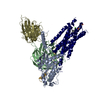



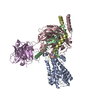
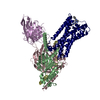
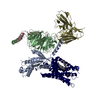
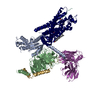

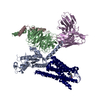
 PDBj
PDBj



























